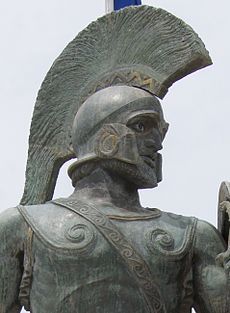What's in a name?
Pity the poor picture editor. This weekend in the Sunday Times there was a short "Olympic trivia feature" -- including reference to the famous ancient athlete, Leonidas of Rhodes, who won three running titles at four successive Olympic Games in the second century BC. Nice to give him his due, but the only trouble was that the piece was illustrated by a picture of his namesake Leonidas King of Sparta, who had lived 300 years earlier and died "heroically" (and pointlessly) at the Battle of Thermopylae.
It is true that I had a pedant moment, and a sense of annoyance that somehow getting such things right doesn't seem to matter very much, when you are talking 2000 years ago. I mean they are all Greek, aren't they? Who cares which Leonidas, or even that there were more than one.
But the truth is that all kinds of people have trouble with Greek and Roman names.
Classicists themselves are a bit to ready to assume that the same names are likely to refer to the same person. Sometimes that is a fair bet. I like to think that the Syrian "Barates" from Palmyra who put up a tombstone to his wife Regina near Hadrian's Wall was the same as the "Ba]rathes Palmyrenus" whose own tombstone has been discovered at nearby Corbridge (although we have to admit that Barates is a fairly common Syrian name and the spelling is slightly different different, and the "Ba" is missing in the second inscription anyway).
But all too often we are asked to believe that a "Jucundus" here is the same as a "Jucundus" a hundred miles away (and maybe a hundred years as well).Never mind the fact that there were any number of Romans with that name. It is a bit like assuming that I am the same as, or related to, the "other" Mary Beard.
But there is a particularly intriguing variant on this in the highest echelons of the Roman imperial court. In original Roman nomenclature, there is an awful lot of overlap between one imperial prince or princess and the others. This could be manipulated to make a point. One of the original names of the emperor Tiberius was "Nero" and at one point Tacitus actually calls him that -- presumably to suggested a close resemblance with the emperor more usually known as Nero.
It is even more striking with the women, half of whom turn out to be called Agrippina (not just the two we now tend to know as Agrippina the "elder" and the "younger"). Rober Graves in I, Claudius tried to help the innocent reader by calling them things like "Agripinilla". And even the Romans would sometimes use different names entirely for the sake of clarity. And that's where a little puzzle I've mentioned before comes in.
The Rubens painting above (in the National Gallery in Washington DC) was traditionally known as "Tiberius and Agrippina", but art historians began to worry that such a title was really very odd. Tiberius had, after all, had Agrippina (the elder) put to death. It was hard to imagine that that pair would have been shown in tandem like this. So it became regularly re-titled as "Germanicus and Agrippina" (Germanicus being Agrippina the elder's husband).
What those who were worried had forgotten was that Tiberius' much loved first wife, whom we regularly call "Vipsania", was also called "Agrippina". No need for retitling at all, then.
It's not only hard pressed picture editors who get their Leonidas's or Agrippinas in a twist.
Mary Beard's Blog
- Mary Beard's profile
- 4107 followers





